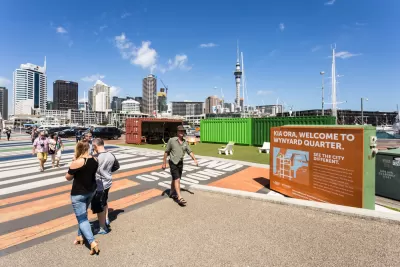A compendium of benefits of walkable urban places, put together by Hazel Borys and Kaid Benfield.

"Whether we’re talking equity, affordability, jobs, health, or a list of other pressing topics, every community strives for more effective outcomes from policies to address a broad range of competing demands. The fact that the demands – and the strategies to address them – are competing for time and resources is its own problem, especially in an era of diminishing trust in cities’ and towns’ capacities to deliver on the collective local vision."
"There’s hope, though, in what we’ve learned about bonuses that come with protecting and expanding compact, mixed-use neighborhoods that aren’t auto-dependent. Here’s a fundamental epiphany: The challenges are interconnected. And so are the solution paths."
Borys goes on to connect some of the many dots – or data points – painstakingly laid out in the cool new tool, Code Score. Lest you be put off by the sound of 135 studies about the paybacks of city planning, know they distill them down to soundbites for you, and deliver them in a couple of ways: paragraph form per topic followed by a bibliography, as well as a downloadable Google Sheet. Their reason why:
"It would be super helpful, would it not, if there was one space on the crowded internet to help us visualize the path between community vision and the strategies and tools for capitalizing on urbanism’s bonuses? And wouldn’t it be great if such a resource also provided a ton of high-quality research to back up the pitch for prioritizing such strategies?"
FULL STORY: Code Score: A New Aid for aligning policy and vision with outcomes

Maui's Vacation Rental Debate Turns Ugly
Verbal attacks, misinformation campaigns and fistfights plague a high-stakes debate to convert thousands of vacation rentals into long-term housing.

Planetizen Federal Action Tracker
A weekly monitor of how Trump’s orders and actions are impacting planners and planning in America.

In Urban Planning, AI Prompting Could be the New Design Thinking
Creativity has long been key to great urban design. What if we see AI as our new creative partner?

Cal Fire Chatbot Fails to Answer Basic Questions
An AI chatbot designed to provide information about wildfires can’t answer questions about evacuation orders, among other problems.

What Happens if Trump Kills Section 8?
The Trump admin aims to slash federal rental aid by nearly half and shift distribution to states. Experts warn this could spike homelessness and destabilize communities nationwide.

Sean Duffy Targets Rainbow Crosswalks in Road Safety Efforts
Despite evidence that colorful crosswalks actually improve intersection safety — and the lack of almost any crosswalks at all on the nation’s most dangerous arterial roads — U.S. Transportation Secretary Duffy is calling on states to remove them.
Urban Design for Planners 1: Software Tools
This six-course series explores essential urban design concepts using open source software and equips planners with the tools they need to participate fully in the urban design process.
Planning for Universal Design
Learn the tools for implementing Universal Design in planning regulations.
Appalachian Highlands Housing Partners
Gallatin County Department of Planning & Community Development
Heyer Gruel & Associates PA
Mpact (founded as Rail~Volution)
City of Camden Redevelopment Agency
City of Astoria
City of Portland
City of Laramie




























